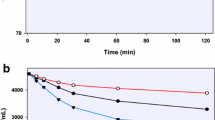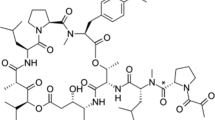Abstract
Objective
Two fluorine-18-labeled analogues, 3-deoxy-3-[18F]fluoro-d-allose (3-[18F]FDA) and 6-deoxy-6-[18F]fluoro-d-allose (6-[18F]FDA), were synthesized and their potentials of diagnostic property were characterized.
Methods
In vitro rat red blood cell (RBC) transport and phosphorylation by yeast hexokinase were evaluated in comparison with 2-deoxy-2-[18F]fluoro-d-glucose ([18F]FDG). The rate of protein binding in pooled human serum was measured by an ultrafiltration method. In vivo metabolite analysis in mice was also performed. Biodistribution, urine excretion, and in vivo renal kinetics in mice were compared with 2-deoxy-2-[18F]fluorosorbitol ([18F]FDS).
Results
Rat RBC uptake of 3- and 6-[18F]FDA (7.8 ± 2.5%ID and 10.2 ± 4.8%ID, respectively) was significantly lower than that of [18F]FDG (44.7 ± 8.7%ID). RBC uptake of 3-[18F]FDA was inhibited by d-glucose (30%) and cytochalasin B (40%), indicating the involvement of GLUT1-dependent transport. In contrast, 6-[18F]FDA transport was not inhibited by d-glucose and cytochalasin B. 3- and 6-[18F]FDA were not phosphorylated by yeast hexokinase under the conditions that result in 60% conversion of [18F]FDG into [18F]FDG-6-phosphate within 30 min. Serum protein binding of 3- and 6-[18F]FDA was negligible. Metabolic transformation of both tracers was not detected in plasma and urine at 30 min after injection. The highest tissue uptake of both tracers was observed in kidneys. Heart and brain uptake of both tracers was below blood levels throughout the biodistribution studies (until 120 min after injection). No significant uptake in the bone was observed, indicating the absence of de-fluorination in mice. In vivo PET imaging visualized rapid excretion of the administered 3- and 6-[18F]FDA from the kidneys, with minimal tracer accumulation in other organs. The urine excretion rate of 3-[18F]FDA was much lower than that of 6-[18F]FDA and [18F]FDS.
Conclusions
3- and 6-[18F]FDA might be unsatisfactory for tumor imaging. In contrast, these tracers demonstrated high levels of kidney uptake and excretion, low serum protein binding, and high metabolic stability as preferable properties for renal imaging. Notably, the urine excretion rate and kidney uptake kinetics of 6-[18F]FDA were comparable with those of the potential renal imaging agent [18F]FDS. Further validation studies in animal models are required to confirm the feasibility of 6-[18F]FDA as a functional renal imaging agent.






Similar content being viewed by others
References
Gao D, Kawai N, Tamiya T. The anti-inflammatory effects of D-allose contribute to attenuation of cerebral ischemia-reperfusion injury. Med Hypothesis. 2011;76:911–3.
Gao D, Kawai N, Nakamura T, Lu F, Fei Z, Tamiya T. Anti-inflammatory effect of d-allose in cerebral ischemia/reperfusion injury in rats. Neurol Med Chir (Tokyo). 2013;53:365–74.
Shinohara N, Nakamura T, Abe Y, Hifumi T, Kawakita K, Shinomiya A, Tamiya T, Tokuda M, Keep RF, Yamamoto T, Kuroda Y. D-Allose attenuates overexpression of inflammatory cytokines after cerebral ischemia/reperfusion injury in Gerbil. J Stroke Cerebrovasc Dis. 2016;25:2184–8.
Ishihara Y, Katayama K, Sakabe M, Kitamura M, Aizawa M, Takara M, Itoh K. Antioxidant properties of rare sugar d-allose: effects on mitochondrial reactive oxygen species production in Neuro2A cells. J Biosci Bioeng. 2011;112:638–42.
Kashiwagi H, Asano E, Noguchi C, Sui L, Hossain A, Akamoto S, Okano K, Tokuda M, Suzuki Y. Beneficial effect of D-allose isolated islet culture prior to islet transplantation. J Hepatobiliary Pancreat Sci. 2016;23:37–42.
Yamada K, Noguchi C, Kamitori K, Dong Y, Hirata Y, Hossain MA, Tsukamoto I, Tokuda M, Yamaguchi F. Rare sugar D-allose strongly induces thioredoxin-interacting protein and inhibits osteoclast differentiation in Raw264 cells. Nutr Res. 2012;32:116–23.
Kimura S, Zhang GX, Nishiyama A, Nagai Y, Nakagawa T, Miyanaka H, Fujisawa Y, Miyatake A, Nagai T, Tokuda M, Abe Y. D-Allose, an all-cis aldo-hexose, suppresses development of salt-induced hypertension in Dahl rats. J Hypertens. 2005;23:1887–944.
Hirooka K, Miyamoto O, Jinming P, Du Y, Itano T, Baba T, Tokuda M, Shiraga F. Neuroprotective effects of d-allose against retinal ischemia-reperfusion injury. Invest Ophthalmol Vis Sci. 2006;47:1653–7.
Liu Y, Nakamura T, Toyoshima T, Shinomiya A, Tamiya T, Tokuda M, Keep RF, Itano T. The effects of d-allose on transient ischemic neuronal death and analysis of its mechanism. Brain Res Bull. 2014;109:127–31.
Sui L, Dong Y, Watanabe Y, Yamaguchi F, Hatano N, Izumori K, Tokuda M. Growth inhibitory effect of d-allose on human ovarian carcinoma cells in vitro. Anticancer Res. 2005;25:2639–44.
Sui L, Dong Y, Wtanabe Y, Yamaguchi F, Hatano N, Tsukamoto I, Izumori K, Tokuda M. The inhibitory effect and possible mechanisms of d-allose on cancer cell proliferation. Int J Oncol. 2005;27:907–12.
Yamaguchi F, Takata M, Kamitori K, Nonaka M, Dong Y, Sui L, Tokuda M. Rare sugar D-allose induces specific up-regulation of TXNIP and subsequent G1 cell cycle arrest in hepatocellular carcinoma cells by stabilization of p27Kip1. Int J Oncol. 2008;32:377–85.
Noguchi C, Kamitori K, Hossain A, Hoshikawa H, Katagi A, Dong Y, Sui L, Tokuda M, Yamaguchi F. d-Allose inhibits cancer cell growth by reducing GLUT1 expression. Tohoku J Exp Med. 2016;238:131–41.
Tewson TJ, Welch MJ, Raichle ME. [18F]-Labeled 3-deoxy-3-fluoro-d-glucose: synthesis and preliminary biodistribution data. J Nucl Med. 1978;19:1339–455.
Neal TR, Schumann WC, Berridge MS, Landau BR. Synthesis of [18F]-6-deoxy-6-fluoro-d-glucose ([18F]6FDG), a potential tracer for glucose transport. J Labelled Comp Radiopharm. 2005;48:845–54.
Ashique R, Chirakal RV, Hughes DW, Schrobligen GJ. Two-step regio- and stereoselective syntheses of [19F]- and [18F]-2-deoxy-2-(R)-fluoro-β-d-allose. Carbohydr Res. 2006;341:457–66.
Ashique R, Chirakal R, Schrobilgen GJ, Hughes DW, Farncombe T, Gulenchyn K, Labiris R, Truman T, Saab C. Reactivity and selectivity of F2 toward 3,4,6-tri-O-acetyl-d-glucal in anhydrous HF: synthesis of [18F]2-fluoro-2-deoxy-β-d-allose and its use for the detection of a breast tumor. In: Gakh AA, Kirk KL, editors. ACS Symposium Series (Fluorinated Heterocycles) Vol. 1003, Chapter 10, 2019. pp. 211–235.
Iga Y, Matsuo T. D-allose metabolism in rats. J Jpn Soc Nutr Food Sci 2010;63:17–9 (Japanese)
Wakabayashi H, Werner RA, Hayakawa N, Javadi MS, Xinyu C, Hermann K, Rowe SP, Lapa C, Higuchi T. Initial preclinical evaluation of 18F-fluorodeoxysorbitol PET as a novel functional renal imaging agent. J Nucl Med. 2016;57:1625–8.
Werner RA, Wakabayashi H, Chen X, Hirano M, Shinaji T, Lapa C, Rowe SP, Javadi MS, Higuchi T. Functional renal imaging with 18F-FDS PET in rat models of renal disorders. J Nucl Med. 2018;59:828–32.
Werner RA, Ordonez AA, Sanchez-Bautista J, Marcus C, Lapa C, Rowe SP, Pomper MG, Leal JP, Lodge MA, Javadi MS, Jain SK, Higuchi T. Novel functional renal PET imaging with 18F-FDS in human subjects. Clin Nucl Med. 2019;44:410–1.
Li ZB, Wu Z, Cao Q, Dick DW, Tseng JR, Gambhir SS, Chen X. The synthesis of 18F-FDS and its potential application in molecular imaging. Mol Imaging Biol. 2008;10:92–8.
Minosako Y, Nemoto M, Ino S, Shirakami Y, Kurami M. Uptake of FDG (2-fluro-2-deoxy-d-glucose) as a tumor imaging agent into erythrocytes and accumulation of FDG in tumor cell. Kaku Igaku 2003;40:23–30 (Japanese)
Van Rijn CJS, Herscheid JDM, Visser GWM, Hoekstra A. On the stereoselectivity of the reaction of [18F]acetylhypofluorite with glucals. Int J Appl Radiat Isot. 1985;36:111–5.
Amini N, Nakao R, Schou M, Halldin C. Determination of plasma protein binding of positron emission tomography radioligands by high-performance frontal analysis. J Pharm Biomed Anal. 2014;98:140–3.
Ishii K, Kikuchi Y, Matsuyama S, Kanai Y, Kotani K, Ito T, Yamazaki H, Funaki Y, Iwata R, Itoh M, Yanai K, Hatazawa J, Itoh N, Tanizaki D, Amano D, Yamada M, Yamaguchi T. First achievement of less than 1 mm FWHM resolution in practical semiconductor animal PET scanner. Nucl Instrum Meth A. 2007;576:435–40.
Loten EG, Regen DM, Park CR. Transport of D-allose by isolated fat-cells: an effect of adenosine trisphosphate on insulin stimulated transport. J Cell Physiol. 1976;89:651–60.
Ullrey DB, Kalckar HM. Search for cellular phosphorylation products of D-allose. Proc Natl Acad Sci USA. 1991;88:1504–5.
Werner RA, Chen X, Lapa C, Koshino K, Rowe SP, Pomper MG, Javadi MS, Higuchi T. The next era of renal radionuclide imaging: novel PET radiotracers. Eur J Nucl Med Mol Imaging. 2019. https://doi.org/10.1007/s00259-019-04359-8.
Hofman MS, Hicks RJ. Gallium-68 EDTA PET/CT for renal imaging. Semin Nucl Med. 2016;46:448–61.
Qin Z, Hoh CK, Olson ES, Jahromi AH, Hall DJ, Barback CV, You Y-H, Yanagita M, Sharma K, Vera DR. Molecular imaging of the glomerulus via mesangial cell uptake of radiolabeled tilmanocept. J Nucl Med. 2019. https://doi.org/10.2967/jnumed.118.223727.
Lipowska M, Jarkas N, Voll RJ, Nye JA, Klenc J, Goodman MM, Taylor AT. Re(CO)3([18F]FEDA), a novel 18F PET renal tracer: radiosynthesis and preclinical evaluation. Nucl Med Biol. 2018;58:42–50.
Awasthi V, Pathuri G, Agashe HB, Gali H. Synthesis and in vivo evaluation of p-18F-fluorohippurate as a new radiopharmaceutical for assessment of renal function by PET. J Nucl Med. 2011;522:147–53.
Acknowledgements
We thank Mr. Kosuke Nishino and Mr. Masanari Sakai for their technical support with the cyclotron operation and radiosynthesis.
Funding
This work was supported in part by a Grant-in-Aid for Scientific Research (C) No. 18K07658 from the Japan Society for the Promotion of Science and a grant from the Japan Science and Technology Agency SENTAN No. JPMJSN16A1.
Author information
Authors and Affiliations
Corresponding author
Ethics declarations
Conflict of interest
Jun Toyohara received a research grant from Sumitomo Heavy Industries (Tokyo, Japan). Hiroyuki Yamamoto and Tetsuro Tago declare that they have no conflict of interest.
Additional information
Publisher's Note
Springer Nature remains neutral with regard to jurisdictional claims in published maps and institutional affiliations.
Electronic supplementary material
Below is the link to the electronic supplementary material.
Rights and permissions
About this article
Cite this article
Toyohara, J., Yamamoto, H. & Tago, T. Searching for diagnostic properties of novel fluorine-18-labeled d-allose. Ann Nucl Med 33, 855–865 (2019). https://doi.org/10.1007/s12149-019-01398-x
Received:
Accepted:
Published:
Issue Date:
DOI: https://doi.org/10.1007/s12149-019-01398-x




